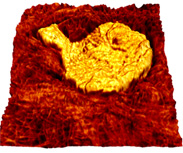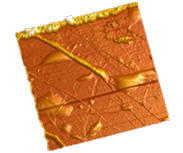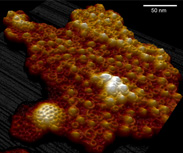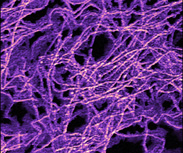Easy to achieve high quality results.


The MultiMode 8-HR is a high resolution AFM for small samples, building on the success of Bruker’s MultiMode® platform, with superior resolution, performance and unparalleled versatility and productivity. The MultiMode 8-HR provides significantly improved imaging speed, resolution and nanomechanical performance, with higher speed PeakForce Tapping®, enhanced PeakForce QNM®, new FastForce Volume™ and exclusive Bruker probe technology.
Easy to achieve high quality results.
Wide choice of modes.
With no compromise in quality.
Image in air and fluid, and a variety of temperatures.
More research has been published using Bruker MultiMode AFM systems than any other model.
“Thanks to PeakForce QNM, we were able to rapidly obtain pertinent information on the mechanical properties of very soft and sticky polymer materials, such as bioadhesives or adaptive hydrogels, that other classical SPM techniques were not able to provide.”
Philipe Leclère et al, University of Mons (UMONS) Belgium

Bruker atomic force microscopes are widely used in material and polymer science. AFM is particularly suitable for investigating the nanoscale properties of nanocomposite materials. Bruker’s unique PeakForce QNM mode delivers fast, high-resolution mapping of nanomechanical properties including modulus over a wide range (kPa to GPa). Most Bruker AFMs are available with high temperature heating and cooling options, which can be used to investigate polymer phase transitions, as well as many other applications. A wide range of techniques is available, including thermal analysis, electrical property mapping (current and capacitance), and nanoindentation.

A wide range of accessories are available for electrochemical AFM and STM measurements at the nanoscale. These are useful for applications including corrosion, electroplating and battery research. Gloveboxes are available for advanced lithium ion battery research, with sub-ppm control of water and oxygen while utilising the full range of AFM capabilities.

Biological AFM applications include molecular biology, cell biology, mechanobiology, biomaterials and biophysics. All Bruker AFMs can be operated in liquids and many are available with perfusion and heating options. ScanAsyst mode is ideal for biological samples, eliminating the complicated step of “tuning” the cantilever resonance. It also enables stable imaging, immune to set-point drift, with direct control of the tip-sample imaging force and automatically optimised imaging parameters.

Unique PeakForce QNM mode enables fast, high-resolution mapping of nanomechanical properties, including modulus, over a wide range (kPa to GPa). Dedicated application modules enable various electrical measurements, including current mapping (conductive AFM), low current mapping (“Tunneling AFM”, TUNA), and wide range current measurements (Scanning Spreading Resistance, SSRM). The revolutionary PeakForce TUNA mode (exclusive to Bruker) combines the superior force control and nanomechanical property mapping of PeakForce QNM with the high current sensitivity of TUNA. New higher resolution, higher sensitivity surface potential mapping is now also possible.
More AFM research has been published using Bruker MultiMode AFM systems than any other model. Its continued presence at the leading edge of AFM research is due to features that incorporate the latest technology advances:
View all solutions for polymer analysis.
Biomedical, pharmaceuticals, biomaterials and other life science applications.
View our range of solutions for battery and fuel cell research, green energy, semiconductors and solar cells.
Ringing Mode is a new Bruker AFM mode for enhanced surface adhesion property mapping.
How to map current and conductivity at the nanoscale on fragile samples with AFM, without damaging them or contaminating the probe tip. Useful for lithium battery research, organic photovoltaics and carbon nanotubes.
PeakForce Tapping enables high resolution imaging and extends AFM to areas not previously possible. Map nanoscale properties simultaneously alongside imaging.
A scientific paper has been published in Advanced Materials about studying adhesion in 2D materials with AFM, using the Bruker MultiMode 8.